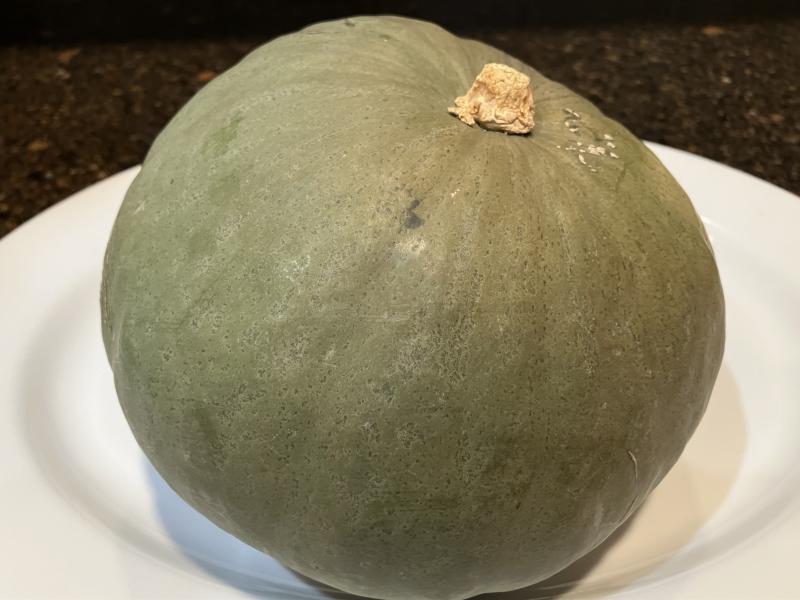Nanticoke squash brings local history to the kitchen
If you happened to walk down Third Street during the past month, as you neared the corner of Shipcarpenter Street you would have seen a patch of vigorous vines growing in the Lewes Historical Society’s Kitchen Garden. Not only were the plant species selected for their likely cultivation during Colonial times, but also, several were specifically chosen for their connection to Delaware, most notably the Nanticoke winter squash.
This squash is considered a “landrace,” an open-pollinated, naturally occurring variant that is connected to a distinct geography. In this case, it is associated with the Nanticoke people of Southern Delaware and the Eastern Shore of Maryland. Because of its botanical classification, cucurbita maxima, we know it originated in Argentina. Food historians believe it found its way to North America in the 1500s.
Unlike commercial hybrids that are developed through selective breeding or genetic engineering, the Nanticoke squash is quite unpredictable in its appearance. The one in the photo has a greenish-greyish cast to its rind, with traces of blackish stippling. You can find Nanticoke squash in a wide range of colors including orange, coral, white, gold and red, with blue, pink and grey as the most common. This one has a slight “turban” quality, while others have stripes or splotches of color, and some are found in different shapes.
The seeds used to grow the squash at the historical society came from the Experimental Farm Network Seed Store, which originally sourced its first seeds from the Seed Savers Exchange seed bank in Iowa. To honor the connection to the first people who share their name with the squash, EFN donates 25 percent of the proceeds from sales of these seeds to the Nanticoke Lenni-Lenape Nation.
Most purveyors of plant seeds don’t offer landrace varieties, specifically because they can’t predict exactly what will grow from the seeds, something most home gardeners demand. However, it is this very quality that makes landraces valuable to agricultural biodiversity and what allows modern growers the opportunity to appreciate the unexpected in a non-hybridized varietal.
In addition to prolific diversity, Nanticoke winter squash has a unique flavor profile. Unlike the quiet or bland nature of most winter squash, these have a faint tannin hint, similar to the notes you’ll find in a cup of black tea. It’s almost sweet and almost sharp at the same time, making it an excellent ingredient in a creamy (or chunky) winter squash soup. Next time you make a minestrone or vegetable soup, add chopped squash for extra texture, flavor and nutritional value.
Keep in mind that winter squash of any variety will keep nicely if left it in a dark corner on the kitchen counter at room temperature for a few weeks. Avoid refrigeration, as the moisture isn’t ideal for the squash. The recipes below work for Nanticoke squash as well as other varieties of thick-skinned winter squash. And, if you’re looking for a Nanticoke squash, you may want to grow your own for next year’s harvest.
Savory Winter Squash Soup*
1 winter squash
1 russet potato
3 carrots
1 large onion
3 C vegetable broth
2 fresh thyme sprigs
1 fresh rosemary sprig
salt & pepper, to taste
Preheat oven to 375 F. Cut the squash in half and remove the seeds (save them to plant in the spring). Place squash cut-side down on a rimmed baking sheet. Peel potatoes and cut into chunks; scatter among squash. Trim the ends from the carrots (peel if necessary) and cut into 2-inch-long pieces; scatter the carrots around the squash. Trim, peel and quarter the onion; scatter pieces around the baking sheet. Roast until softened, about 25 to 30 minutes. Place chopped vegetables and broth in a soup pot along with herbs. Scrape the flesh from the rind of the squash and add to the pot. Simmer for 20 minutes; remove herb sprigs. Using a food processor or a potato masher, purée soup to desired consistency. Season to taste with salt and pepper. Yield: 6 to 8 servings. *Adapted from Bill Hicks.
Apple & Winter Squash Soup*
1 chopped onion
4 chopped bacon slices
2 T minced garlic
2 apples
2 T olive oil
salt and pepper
1 t sage
1/2 C dry white wine
6 C vegetable broth
Squash Gnocchi*
1 lb Yukon gold potatoes
1 lb winter squash cubes
1/2 t salt
2/3 C fine flour
whole nutmeg
Peel and cube potatoes. Place potatoes and squash in a large pot with salt and enough water to cover. Bring to a boil and simmer until tender, about 15 minutes. Drain in a colander. Transfer mixture to a kitchen towel and wring to remove any excess liquid. Place mixture in a mixing bowl and sprinkle with flour; grate in about half the nutmeg. Mix well and knead on a flat surface until pliable. Form into 4 logs about 3/4-inch thick. Slice into 3/4-inch pieces and allow to rest until ready to cook. To cook gnocchi, bring a large pot of salted water to boil. Add gnocchi and cook until the pieces rise to the surface, about 2 or 3 minutes. Remove cooked gnocchi to a plate to rest for about 30 seconds before serving. Serve with brown butter and grated Parmesan cheese. Yield: 4 servings. *Adapted from Jamie Oliver.



















































